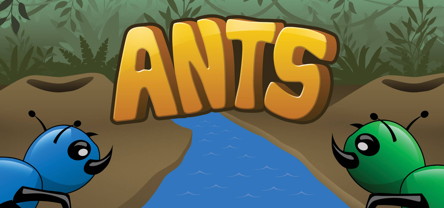|
After another room service breakfast (the hotel managed to mess up our order again, though), we
drove to The Warehouse to return the Lord of the Rings figures. While we were driving we made the mistake
of listening to the radio. The announcers were getting some American tourist to play a song on a zipper.
I don't know if the zipper was still attached to someone.
We stopped at an outdoor store, where Jean discovered Ice Breaker, a New Zealand company which
sells outdoor clothing made of merino wool. They claim that it doesn't hold odor (okay, they say odour),
so it would be great for backpacking. We'll see about that. While I was at the store I found a
magazine which described all the places in New Zealand where Lord of the Rings was filmed.
It was bright and sunny as we checked out of the hotel and started the drive to Arthur's Pass.
It's pretty flat open road for the first 60 or 70 kilometers. We basically headed due west, toward the
Southern Alps. As we drove closer we had great views of the mountains, which didn't appear to have any
snow. In fact, they were pretty bare of vegetation or snow at the top. We drove along, sheep on one
side, cows on the other, before eventually starting to wind our way through the mountains.
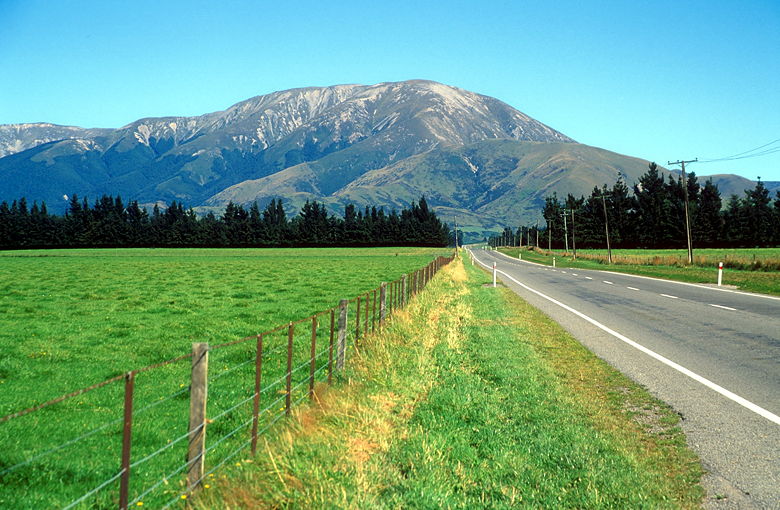
On the road to Arthur's Pass
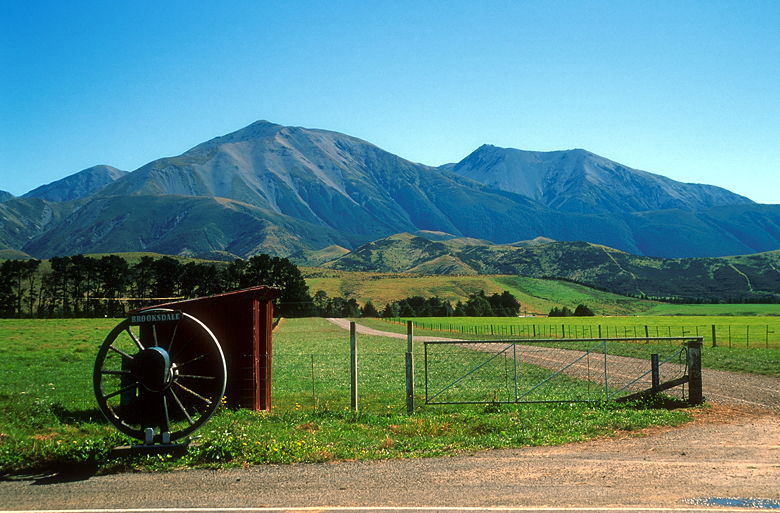
Looking out at the mountains to come
After some time we passed an interesting set of rock formations protruding from some green
hills, called Castle Hill. Apparently it's a spiritual place for new age folk, and also
popular with rock climbers. Not long
after this we ran into a traffic jam. Someone was mustering thousands of sheep across the road right in
front of us, stopping traffic. Cars slowly inched their way forward, and the sheep would run from one side of
the road to the other. I got clear of most of them, but then a bunch ran off ahead of me and I had to
repeat the process. Just as we escaped the herd a cyclist passed us by. I noticed he had an REI tent
and drove up beside him to ask if he was from the United States. In fact, he was from Los Angeles, doing
some bike touring in New Zealand.
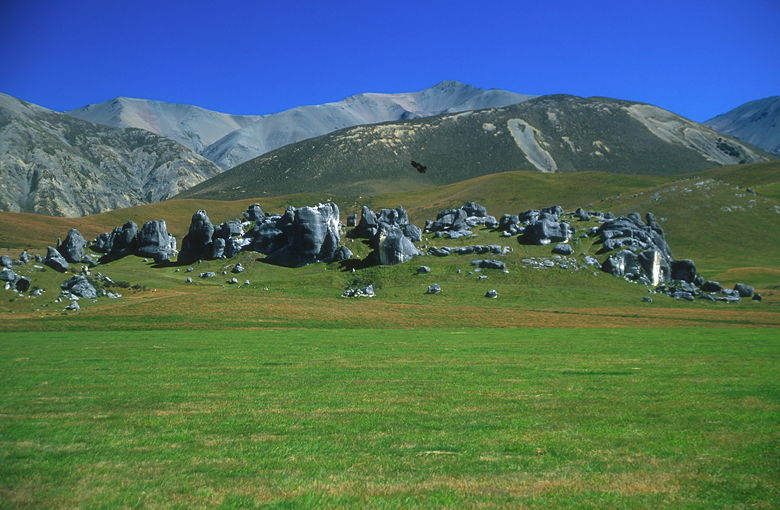
Castle Hill

Sheep mustering across the road
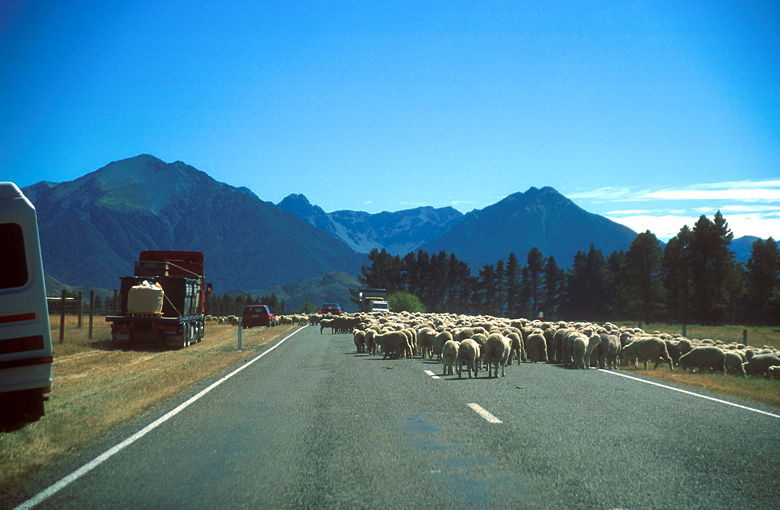
Sheep mustering across the road
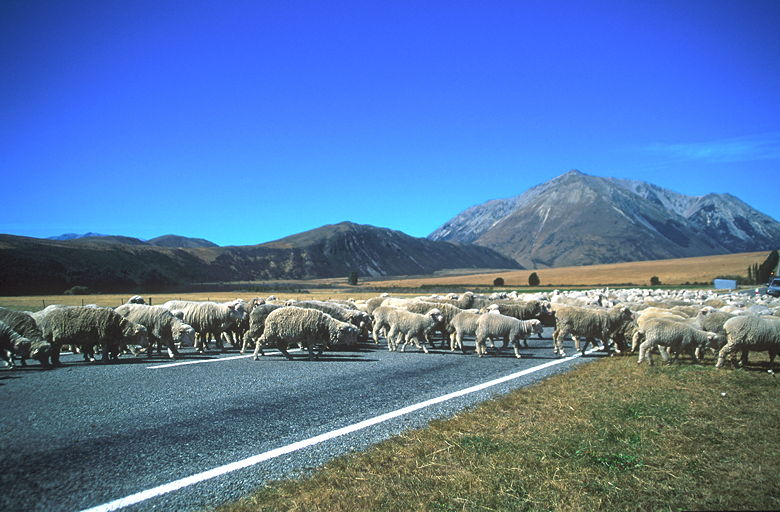
Sheep mustering across the road
After about 90 minutes of driving, we came to the Arthur's Pass Wilderness Lodge. We drove past sheep fenced in on the left and up a gravel road to the lodge itself. We
checked in and had a nice lunch in the dining area. It was late (about 1:30pm), but they accommodated us.
The dining area has big windows which provide views of the Bealey River valley and the mountains surrounding
it, including a view of snow-peaked Mt. Rolleston, the highest in the area. The lodge itself is a
beautiful place, having just been completed in 1996. Lots of wood, a fireplace, a small library, and
lots of high ceilings in the common areas. The rooms are simple but comfortable.
While Jean took a nap, I drove up to Arthur's Pass township. There didn't seem to be much to see, so I drove
as far as Otira Valley before turning around. The road is narrow and twisting, but not nearly as bad as the
road to Anakiwa. And I have to say the views from the road aren't nearly as good as the views from the wilderness
lodge. There's a turnoff with a decent view of Mt. Rolleston, and a turnoff with a view of the Otira Valley;
unfortunately, power lines mar the view downhill to the west, so I was disappointed and didn't take any pictures
there.

Mt. Rolleston

Bridge over Bealey River
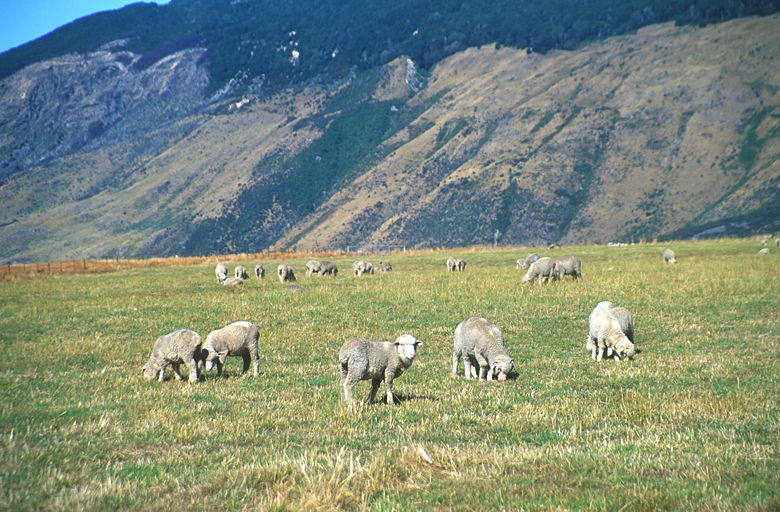
Sheep at Cora Lynn Station
I returned to the lodge around 4pm, just in time to go for a short hike before a guided walk at
6pm. Jean decided not to join me, so I went off on my own on the Rainbow Nature Hike. After the hike I joined Jean and 3 other guests on a guided walk. It turns out that two of
the guests were a couple from Los Altos (their names were Jean and Allen). We all walked downhill and across
the sheep farm. The guide answered all our questions about the flora and fauna. We noticed trees planted
on the hillside to the west. Apparently they're douglas fir planted in the 1960s to replace what had been
lost by fire. They're not for logging.
You might think that New Zealand checks for fruits and meats to save its ecosystem, but they
do it mainly to preserve their agriculture. In fact, according to the guide, they've already lost the
battle to preserve the biological integrity of the island. They've already lost about 80% of their
original vegetation (by area, not species), and half the birds on the island are non-native -- what the
guide refers to as "exotics". Interestingly, fir and pine and other such trees which are common in
California are all referred to as exotics in New Zealand, since they're non-native. It's a different
perspective when you look at a beautiful tree but realize that it shouldn't really be there.
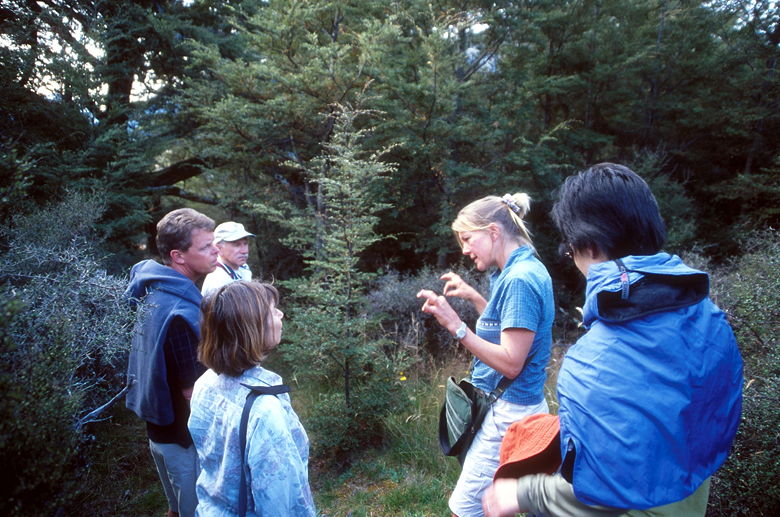
Our guide explaining the native plants
The guide (I'm sorry I've forgotten her name) lamented the spreading of blackberries and the
demise of the Moa -- a flightless bird hunted to extinction by the Maori about 500 years ago. She
taught us some of the basics of sheep farming -- 70 girls for every guy, so to speak. She mentioned
species of bird which flew all the way from Australia in the 1940's or 50's. She talked a lot
about the different species of plants which grow in the Broad Stream bed across the property. If exotics
were introduced, they would probably wipe out most of the native species in the fragile environment
of the stream bed.
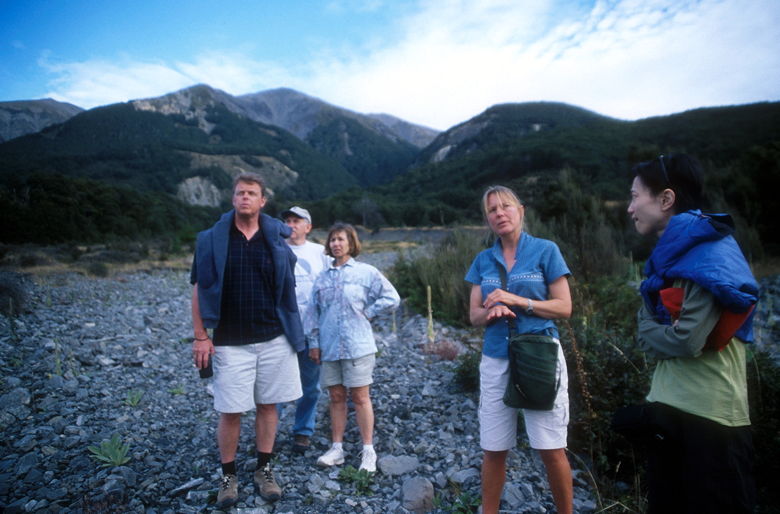
Group looking out across the Bealey River valley
We had a tight schedule to keep, so we walked briskly back in time for a quick shower before
dinner. Everyone at the lodge eats dinner at the same time. You can tell them whether you want to dine
alone or with company for the night. With only 20 guest rooms, it's a cozy arrangement. Tonight,
there were about 22 guests -- 10 in a group from Japan, 2 from Australia, us 4 Americans, 2 Dutch, and
2 from England. We'd decided to dine alone for tonight, though after seeing how friendly people were,
we wouldn't have minded some company. We'd save that for the following night.
The food at the lodge is excellent. We started off with a mushroom and onion soup. Then
it was grouper fish with kumera mash and vegetables. The grouper was from the west coast, further north.
The water, taken from the stream running through the property, tasted great. For dessert, we had
chocolate ice cream and some blueberries which the Australian couple had picked earlier in the day.
We asked the lodge to pack us a box lunch for tomorrow. We asked the waitress about the merits of
hiking Avalanche Peak versus Bealey Spur; she was gung-ho on going for Avalanche Peak, but I wasn't
sure if we'd have time to do it and still be back in time for one of the lodge events in the afternoon.
We decided we'd wait until the morning to decide which to do.
| 










